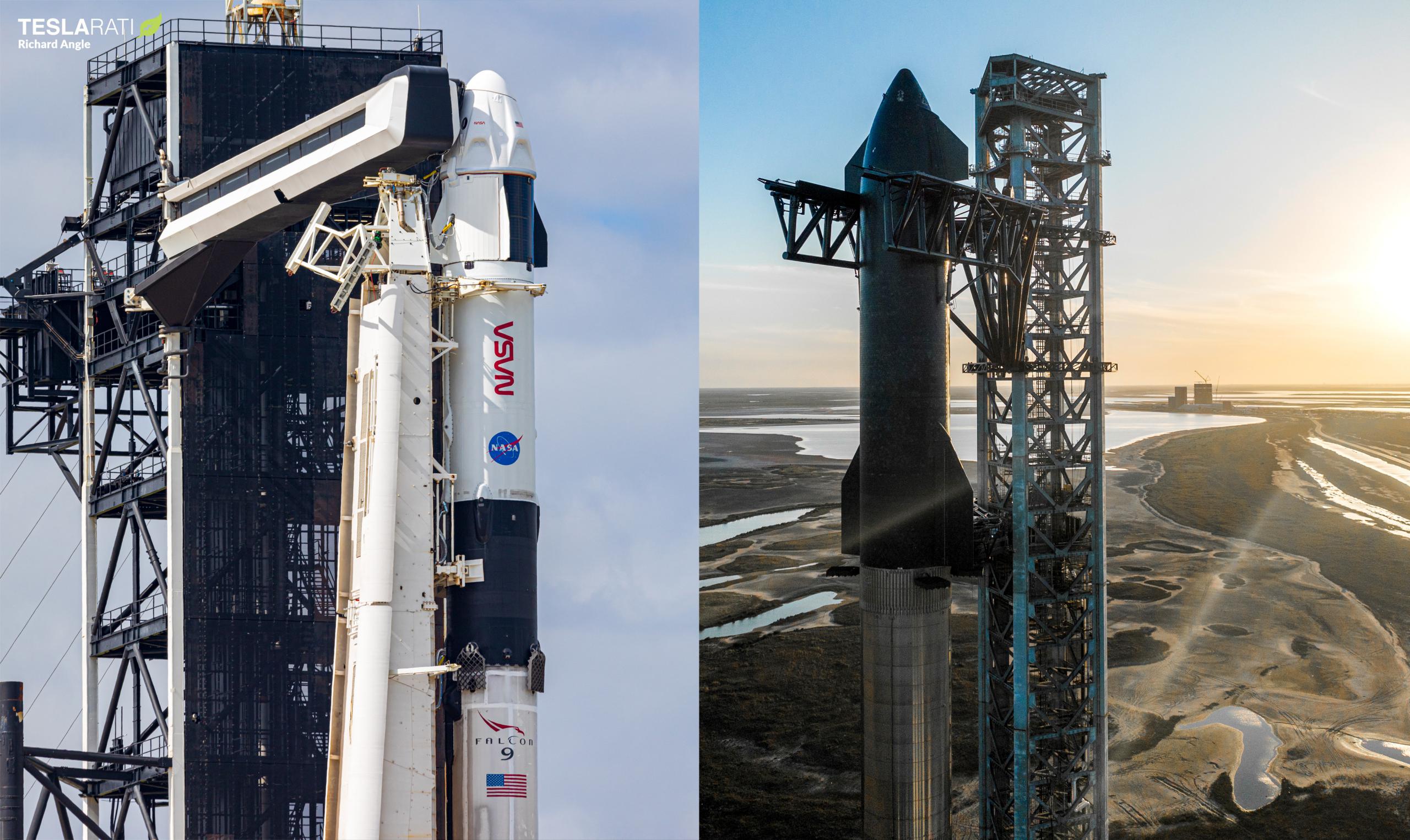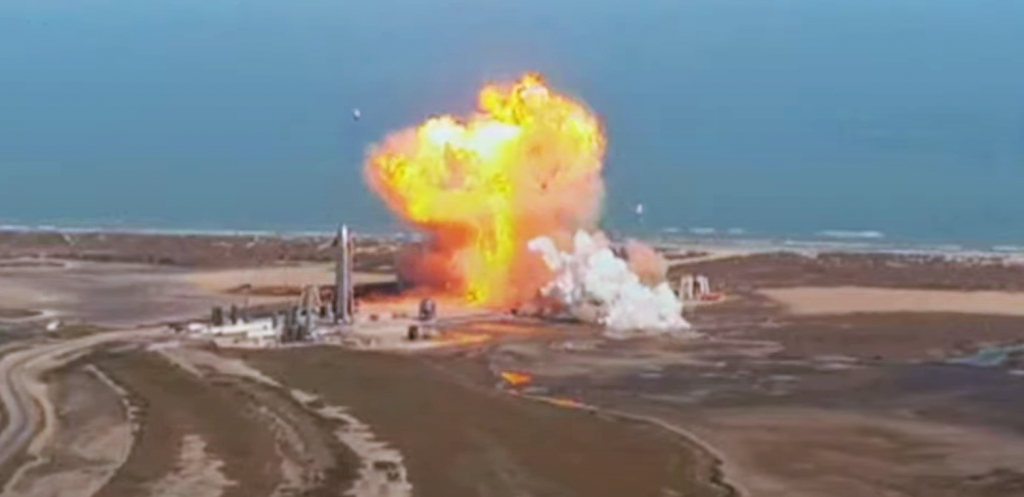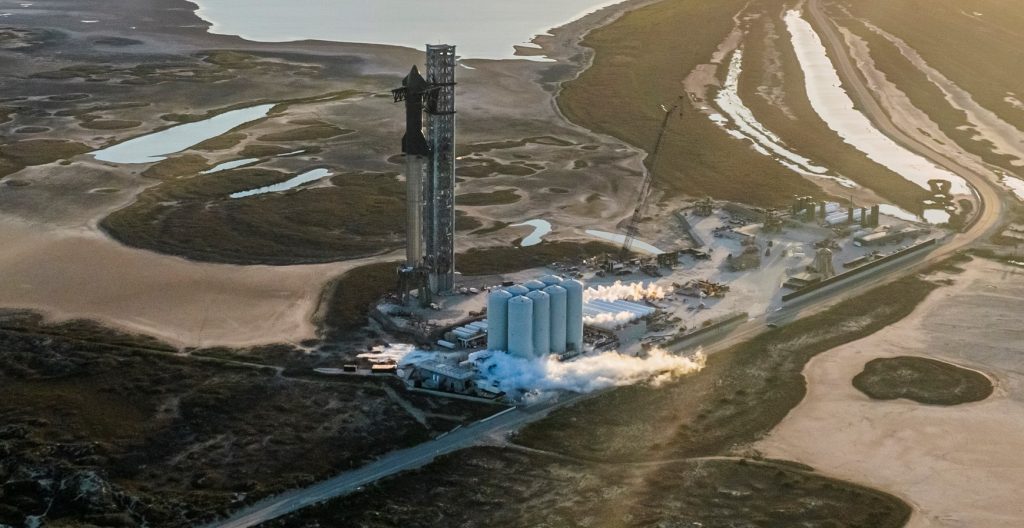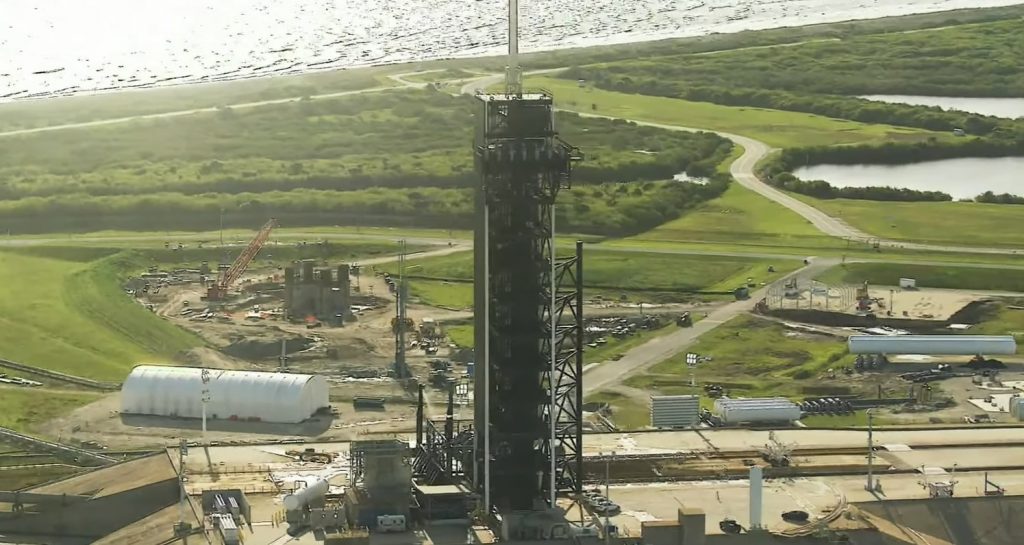

News
SpaceX considers second Crew Dragon launch pad to reduce risk from Starship
Reuters reports that SpaceX has proposed modifying a second Florida launch pad to support Crew Dragon missions after NASA raised concerns about the threat posed by plans to launch Starship out of the only pad currently certified for Dragon.
After more than a year of downtime, SpaceX restarted the construction of an orbital Starship launch site at NASA’s Kennedy Space Center LC-39A pad in late 2021. SpaceX has leased Pad 39A since 2014 and conducted 49 Falcon rocket launches out of the facility since its first use in 2017. Prior to SpaceX’s lease, Pad 39A supported 82 Space Shuttle launches from 1981 to 2011 and every Apollo Program launch to the Moon in the 1960s and 1970s, making it one of the most storied and well-used launch sites in the history of US spaceflight.
In 2018, Pad 39A began supporting launches of SpaceX’s Falcon Heavy, which was and still is the most powerful and capable rocket currently in operation. In May 2020, a Falcon 9 rocket and Crew Dragon spacecraft lifted off with two NASA astronauts in tow, marking SpaceX’s first human spaceflight and the United States’ first domestic astronaut launch of any kind since 2011. The next era of the historic pad could include Starship, a fully-reusable two-stage rocket that SpaceX has been developing in earnest since the mid-2010s. However, NASA is worried that a failure of that immense and unproven rocket could almost instantly destroy what is currently the only launch pad on Earth capable of launching the space agency’s astronauts to the International Space Station (ISS).
One certainly can’t blame NASA for worrying. In its latest iteration, SpaceX’s Starship 39A launch mount will sit roughly 1000 feet (~300m) East of Pad 39A’s existing Falcon launch facilities, which include a tower and arm that are needed for astronauts and cargo to access and board Crew and Cargo Dragons. The Starship mount is also around 1600 feet (~500m) northeast of Pad 39A’s lone horizontal integration hangar, without which Falcon launch operations would become far more difficult or even impossible.
For the Falcon pad and tower, there is a slight consolation: Starship’s own skyscraper-sized launch tower will be located directly between those Falcon facilities and Starship before and during launches and could partially protect them from any hypothetical blast. The hangar will be fully unprotected, however.


NASA is worried that if a Starship fails before or shortly after launch and explodes at or near its adjacent launch mount, it could destroy or damage the infrastructure the space agency and SpaceX need to launch Crew Dragon to the International Space Station (ISS). At the moment, Boeing – NASA’s second Commercial Crew partner – is likely a year or more away from its first operational astronaut launch, during which Falcon 9 and Crew Dragon will remain a single point of failure that could theoretically sever the space agency’s connection to its own space station at any moment.
In response to NASA’s concern, NASA executive Kathy Lueders – in an interview with Reuters – says that SpaceX has begun working with the agency on plans to both “harden” Pad 39A and modify its Cape Canaveral Space Force Station (CCSFS) LC-40 pad to support Dragon launches. According to Reuters, however, receiving approval to put those plans into action “could take months.” Depending on how significant the facilities LC-40 would need are, there’s also a chance that SpaceX would need to complete a new FAA environmental review to construct a crew access tower.

Meanwhile, Pad 39A is also the only launch pad in the world capable of supporting Falcon Heavy, which has also become an extremely important rocket for uncrewed NASA spacecraft launches, NASA’s plans to get cargo to its lunar Gateway space station, and to the US military. Modifying one of SpaceX’s other pads to support Falcon Heavy would likely be even harder and take even longer than adding Crew Dragon capabilities to LC-40. In both cases, it’s likely that NASA and the US military would strongly prefer – if they don’t eventually outright require – that SpaceX have backup options already constructed and ready to go before risking the destruction of Pad 39A with its first Starship launch.
39A’s Starship facilities could easily require another 6-12 months of work before they’ll be ready for launch, however, leaving a good amount of time for SpaceX to alleviate the concerns of its US government customers before they might actually start to disrupt plans for East Coast Starship launches.
News
Tesla begins Robotaxi certification push in Arizona: report
Tesla seems serious about expanding its Robotaxi service to several states in the coming months.

Tesla has initiated discussions with Arizona transportation regulators to certify its driverless Robotaxi service in the state, as per a recent report from Bloomberg News. The move follows Tesla’s launch of its Robotaxi pilot program in Austin, Texas, as well as CEO Elon Musk’s recent comments about the service’s expansion in the Bay Area.
The Arizona Department of Transportation confirmed to Bloomberg that Tesla has reached out to begin the certification process for autonomous ride-sharing operations in the state. While details remain limited, the outreach suggests that Tesla is serious about expanding its driverless Robotaxi service to several territories in the coming months.
The Arizona development comes as Tesla prepares to expand its service area in Austin this weekend, as per CEO Elon Musk in a post on X. Musk also stated that Tesla is targeting the San Francisco Bay Area as its next major market, with a potential launch “in a month or two,” pending regulatory approvals.
Tesla first launched its autonomous ride-hailing program on June 22 in Austin with a small fleet of Model Y vehicles, accompanied by a Tesla employee in the passenger seat to monitor safety. While still classified as a test, Musk has said the program will expand to about 1,000 vehicles in the coming months. Tesla will later upgrade its Robotaxi fleet with the Cyercab, a two-seater that is designed without a steering wheel.
Sightings of Cybercab castings around the Giga Texas complex suggests that Tesla may be ramping the initial trial production of the self-driving two-seater. Tesla, for its part, has noted in the past that volume production of the Cybercab is expected to start sometime next year.
In California, Tesla has already applied for a transportation charter-party carrier permit from the state’s Public Utilities Commission. The company is reportedly taking a phased approach to operating in California, with the Robotaxi service starting with pre-arranged rides for employees in vehicles with safety drivers.
News
Tesla sets November 6 date for 2025 Annual Shareholder Meeting
The automaker announced the date on Thursday in a Form 8-K.

Tesla has scheduled its 2025 annual shareholder meeting for November 6, addressing investor concerns that the company was nearing a legal deadline to hold the event.
The automaker announced the date on Thursday in a Form 8-K submitted to the United States Securities and Exchange Commission (SEC). The company also listed a new proposal submission deadline of July 31 for items to be included in the proxy statement.
Tesla’s announcement followed calls from a group of 27 shareholders, including the leaders of large public pension funds, which urged Tesla’s board to formally set the meeting date, as noted in a report from The Wall Street Journal.
The group noted that under Texas law, where Tesla is now incorporated, companies must hold annual meetings within 13 months of the last one if requested by shareholders. Tesla’s previous annual shareholder meeting was held on June 13, 2024, which placed the July 13 deadline in focus.
Tesla originally stated in its 2024 annual report that it would file its proxy statement by the end of April. However, an amended filing on April 30 indicated that the Board of Directors had not yet finalized a meeting date, at least at the time.
The April filing also confirmed that Tesla’s board had formed a special committee to evaluate certain matters related to CEO Elon Musk’s compensation plan. Musk’s CEO performance award remains at the center of a lengthy legal dispute in Delaware, Tesla’s former state of incorporation.
Due to the aftermath of Musk’s legal dispute about his compensation plan in Delaware, he has not been paid for his work at Tesla for several years. Musk, for his part, has noted that he is more concerned about his voting stake in Tesla than his actual salary.
At last year’s annual meeting, TSLA shareholders voted to reapprove Elon Musk’s compensation plan and ratified Tesla’s decision to relocate its legal domicile from Delaware to Texas.
Elon Musk
Grok coming to Tesla vehicles next week “at the latest:” Elon Musk
Grok’s rollout to Tesla vehicles is expected to begin next week at the latest.

Elon Musk announced on Thursday that Grok, the large language model developed by his startup xAI, will soon be available in Tesla vehicles. Grok’s rollout to Tesla vehicles is expected to begin next week at the latest, further deepening the ties between the two Elon Musk-led companies.
Tesla–xAI synergy
Musk confirmed the news on X shortly after livestreaming the release of Grok 4, xAI’s latest large language model. “Grok is coming to Tesla vehicles very soon. Next week at the latest,” Musk wrote in a post on social media platform X.
During the livestream, Musk and several members of the xAI team highlighted several upgrades to Grok 4’s voice capabilities and performance metrics, positioning the LLM as competitive with top-tier models from OpenAI and Google.
The in-vehicle integration of Grok marks a new chapter in Tesla’s AI development. While Tesla has long relied on in-house systems for autonomous driving and energy optimization, Grok’s integration would introduce conversational AI directly into its vehicles’ user experience. This integration could potentially improve customer interaction inside Tesla vehicles.
xAI and Tesla’s collaborative footprint
Grok’s upcoming rollout to Tesla vehicles adds to a growing business relationship between Tesla and xAI. Earlier this year, Tesla disclosed that it generated $198.3 million in revenue from commercial, consulting, and support agreements with xAI, as noted in a report from Bloomberg News. A large portion of that amount, however, came from the sale of Megapack energy storage systems to the artificial intelligence startup.
In July 2023, Musk polled X users about whether Tesla should invest $5 billion in xAI. While no formal investment has been made so far, 68% of poll participants voted yes, and Musk has since stated that the idea would be discussed with Tesla’s board.
-

 Elon Musk1 week ago
Elon Musk1 week agoTesla investors will be shocked by Jim Cramer’s latest assessment
-

 Elon Musk3 days ago
Elon Musk3 days agoElon Musk confirms Grok 4 launch on July 9 with livestream event
-

 Elon Musk16 hours ago
Elon Musk16 hours agoxAI launches Grok 4 with new $300/month SuperGrok Heavy subscription
-

 News7 days ago
News7 days agoTesla Model 3 ranks as the safest new car in Europe for 2025, per Euro NCAP tests
-

 Elon Musk2 weeks ago
Elon Musk2 weeks agoA Tesla just delivered itself to a customer autonomously, Elon Musk confirms
-

 Elon Musk1 week ago
Elon Musk1 week agoxAI’s Memphis data center receives air permit despite community criticism
-

 Elon Musk2 weeks ago
Elon Musk2 weeks agoTesla’s Omead Afshar, known as Elon Musk’s right-hand man, leaves company: reports
-

 News2 weeks ago
News2 weeks agoXiaomi CEO congratulates Tesla on first FSD delivery: “We have to continue learning!”

















